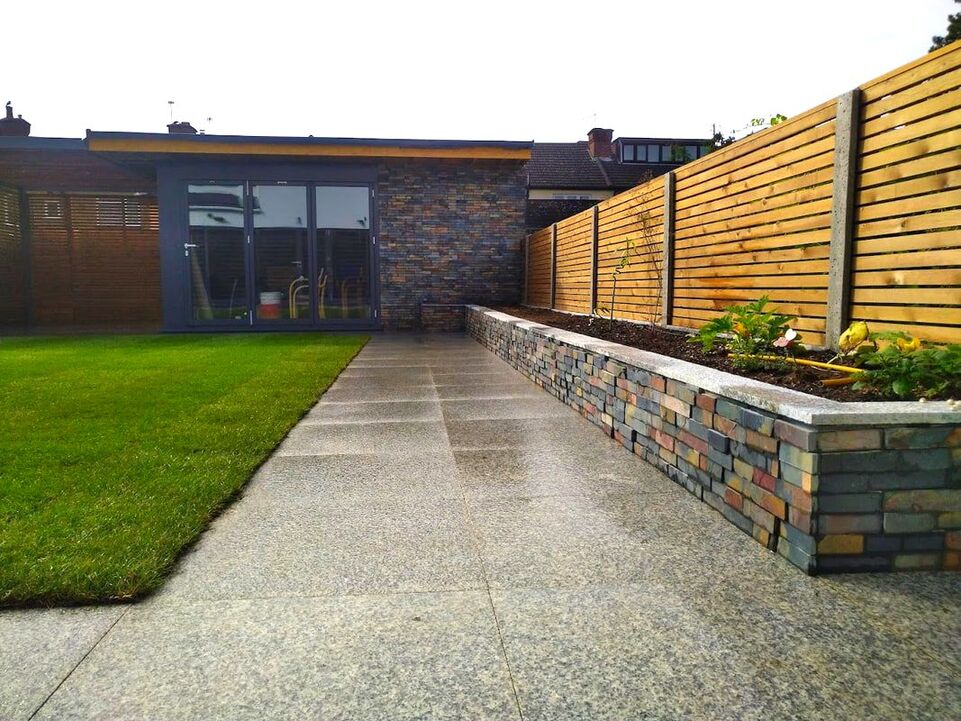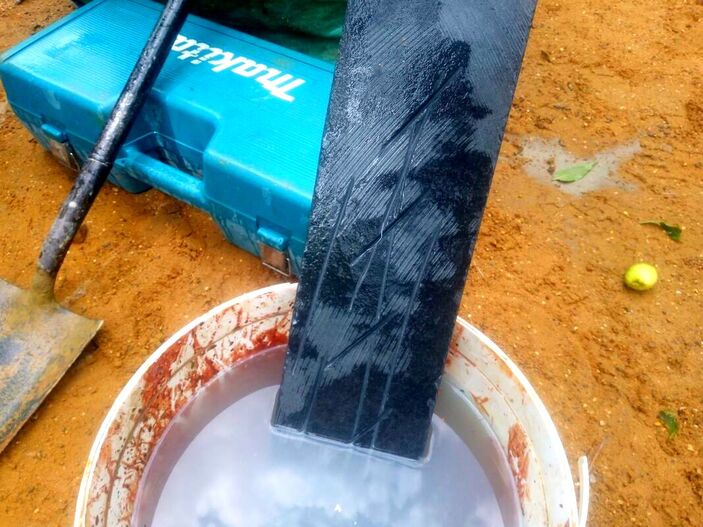|
This article contains affiliate links
Both paving slabs and coping stones are generally made from the same or similar materials.
With coping stones being much more expensive per square metre the question often arises; can you make coping stones with paving? The answer to this question really depends on a few factors and your specific needs. Here I will explain when you can use pavers as coping stones and how to make copings with paving. What is the difference between paving and coping stones?
Coping stones are specifically made to cap off the tops of walls and other masonry construction. Consequently, they have smooth or rounded edges with specific widths to fit standard wall thicknesses. Such widths often allow for a slight overhang over walls to prevent water running over the walls surface. Manufactured copings typically have a drip groove on the underside of the overhang. This captures running water droplets and forces them to drip away from the wall face.
Slate paving utilised as coping stones
In a nutshell, copings are installed to prevent too much rain and dampness penetrating the wall. This protects the wall from freeze and thaw action and discolouration.
Coping stones are generally thick and rounded to provide a robust barrier to the top of masonry. Paving on the other hand is generally thinner with much wider dimensions. This means they are not pre-made to fit standard wall thicknesses. Therefore most paving has edges not visually suited to create wall copings. Can paving be used as coping stones?
Yes, in many circumstances paving can be used as coping stones. It really comes down to if the width of the paving fits the wall well. If it doesn't it means the paving would need to be cut leaving an untidy edge. This is not necessarily a problem if your wall has only one face. Also, some paving materials such as slate are easier to cut neatly than other types of paving. One of the best solutions for using paving as copings is using 300mm x 300mm paving. These can be laid on top of double skinned brickwork or 9 inch walls.
Raised bed coping stones cut from granite patio paving
The 300 x 300 paving can easily be laid on top with 50mm over hang with no need to cut them down.
This is regularly done with natural stones such as Indian sandstone and slate paving. Drip groves can be cut into the underside edge with a grinder. What is the best paving to use for coping stones?
The best paving to use for coping stones is paving with a neat edge. Typically 300x300mm small paving slabs are the perfect width to use as copings for 9 inch walls (double brick thickness). Some of the best paving for copings is either paving with a thickness above 25mm (1 inch). Or natural stone materials that are very impervious to water penetration such as slate paving.
300mm wide Indian sandstone paving slabs
How to make coping stones stick to mortar?
The best way to make coping stones stick to mortar is to cut groves on the underside of the copings. This can be done with an electric grinder with a diamond blade cutting disk. Cut to a depth of around 6mm in a X formation and at a slight angle. As you bed down your copings the mortar will seep up into the groves creating a strong grip.
As copings are subject to multiple stresses and impacts, good mortar penetration into the coping is preferable.
Also be sure to mix your mortar with a good bonding agent such as PVA. Mortar should also contain plasticiser for extra workability and not be too wet or too dry. The best mortar for laying coping stones is one part cement to four parts sand mix. It is better to use a 50% sharp sand and 50% soft sand mix. The mortar should have a consistency of stiff brick laying mortar. Step 1: Select your paving
Select the paving you wish to use for your coping stones. Make sure if you have to cut them that you can achieve a tidy cut to the edge of the paving. See if the paving supplier can provide smaller paving units more ideal for copings. Step 2: Cut your paving
If you have to cut your paving, mark out long strips at the thickness you desire. With a diamond blade cutting disk carefully and slowly, start to cut your paving. Try to keep your disk as square as possible and cut slowly for as smooth a finish as possible. Step 3: Create bedding key
Using your grinder, cut grooves into the base of your coping stones. This will enable your mortar to rise up into the key for a firm bond. Once they have been cut, wash your copings with water to rinse off excess dust. Step 4: Mix up mortar
Mix your mortar with a good bonding agent such as PVA. Mortar should also contain plasticiser and not be too wet or too dry. The best mortar for laying coping stones is one part cement to four parts sand mix. It is better to use 50% sharp sand and 50% soft sand mix. The mortar should have the consistency of a stiff brick laying mortar. Step 5: Bed down your copings
Lay a fillet of mortar on top of your wall creating peaks and valleys. Gradually bed down your copings onto the mortar so they have consistent contact with the mortar below. Tamp them down gradually using a spirit level to keep them flush. Using a pointing trowel cut off any excess mortar and work it to a smooth finish. Step 6: Grout your copings
Using a grouting or pointing mix grout your copings to a neat jointing finish. Why not visit my step by step guide for grouting paving here. Step 7: Curing
Now you have laid your copings make sure they can cure for 24 hours with no disturbance. Any impacts or movements during this process could prevent a strong bond forming. A good idea is to cover them over or tape off the area.
Thank you for reading our article on how to make coping stones with paving. Below I have linked to some other articles you may find informative.
'As an Amazon associate I earn from qualifying purchases'
0 Comments
Leave a Reply. |
The Author
|
Landscaping services across Buckinghamshire, Amersham, Aylesbury & High Wycombe
Hyde Heath, Amersham, Buckinghamshire |
|














